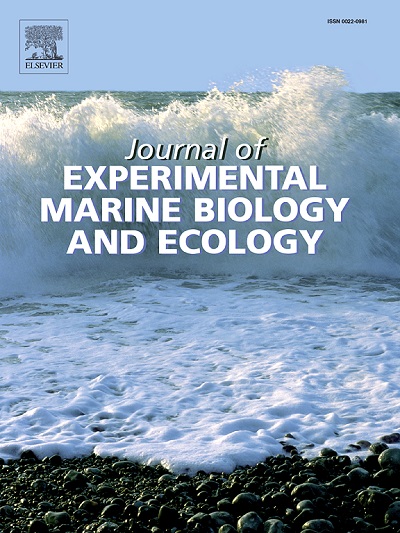Population differentiation of thermal physiology in the temperate coral Astrangia poculata
IF 1.8
3区 生物学
Q3 ECOLOGY
Journal of Experimental Marine Biology and Ecology
Pub Date : 2025-06-11
DOI:10.1016/j.jembe.2025.152114
引用次数: 0
Abstract
Understanding the evolutionary and physiological mechanisms that drive thermal tolerance is crucial to supporting coral conservation and restoration. In the face of climate change, organisms can cope with variable environmental landscapes through adaptive genetic differentiation and phenotypic plasticity. In this study, we utilized a factorial common garden experiment to assess stress tolerance and thermal plasticity of symbiotic colonies of the temperate coral, Astrangia poculata. We collected coral colonies from sites in Massachusetts, Rhode Island, and North Carolina, representing a 7.5° latitudinal range and a 10 °C range in mean summer seawater temperatures. We measured how acclimation of the corals to temperatures representative of summer means at their origin site versus other latitudes impacted basal rates of cellular respiration and photosynthesis, as well as stress indicators including endosymbiont density, chlorophyll fluorescence (Fv/Fm), and chlorophyll a content. We found evidence of heat stress at 32 °C in photosynthetic endosymbionts from all populations, especially those from North Carolina. Metabolic performance of the coral holobiont appears optimized for native conditions (28 °C) in NC populations but appears to be plastic in RI corals, as incubation in warmer than native conditions (28 °C) led to elevated respiration in RI corals. Metabolic performance does not differ between acclimation treatments in MA populations, suggesting both population-specific responses and differential plasticity of metabolic responses to temperature changes. Overall, we see some minimal support for locally adapted thermal maxima in these populations and some evidence of thermal plasticity. Continued work to understand the ecological repercussions of a high capacity for phenotypic plasticity will be important to understanding the long-term tolerance of this species to elevated temperatures predicted with climate change.
温带珊瑚astangia poculata的种群热生理分化
了解驱动热耐受性的进化和生理机制对于支持珊瑚保护和恢复至关重要。面对气候变化,生物可以通过适应性遗传分化和表型可塑性来应对多变的环境景观。在本研究中,我们利用因子普通花园实验来评估温带珊瑚共生群落的抗逆性和热可塑性。我们从马萨诸塞州,罗德岛州和北卡罗来纳州的站点收集珊瑚群落,代表纬度7.5°范围和夏季平均海水温度10°C范围。我们测量了珊瑚对其原产地与其他纬度的夏季代表温度的适应如何影响细胞呼吸和光合作用的基本速率,以及包括内共生体密度、叶绿素荧光(Fv/Fm)和叶绿素a含量在内的应激指标。我们在所有种群的光合内共生体中发现了32°C热应激的证据,特别是来自北卡罗来纳州的种群。在NC种群中,珊瑚全息生物的代谢性能在原生条件(28°C)下似乎是最佳的,但在RI珊瑚中似乎是可塑的,因为在比原生条件(28°C)更温暖的条件下孵育导致RI珊瑚的呼吸升高。不同的驯化处理对MA种群的代谢性能没有影响,这表明了种群对温度变化的特异性反应和代谢反应的差异性可塑性。总的来说,我们在这些种群中看到了一些局部适应的热最大值的最小支持和一些热可塑性的证据。继续了解高表型可塑性的生态影响,对于了解该物种对气候变化预测的高温的长期耐受性非常重要。
本文章由计算机程序翻译,如有差异,请以英文原文为准。
求助全文
约1分钟内获得全文
求助全文
来源期刊
CiteScore
4.30
自引率
0.00%
发文量
98
审稿时长
14 weeks
期刊介绍:
The Journal of Experimental Marine Biology and Ecology provides a forum for experimental ecological research on marine organisms in relation to their environment. Topic areas include studies that focus on biochemistry, physiology, behavior, genetics, and ecological theory. The main emphasis of the Journal lies in hypothesis driven experimental work, both from the laboratory and the field. Natural experiments or descriptive studies that elucidate fundamental ecological processes are welcome. Submissions should have a broad ecological framework beyond the specific study organism or geographic region.
Short communications that highlight emerging issues and exciting discoveries within five printed pages will receive a rapid turnaround. Papers describing important new analytical, computational, experimental and theoretical techniques and methods are encouraged and will be highlighted as Methodological Advances. We welcome proposals for Review Papers synthesizing a specific field within marine ecology. Finally, the journal aims to publish Special Issues at regular intervals synthesizing a particular field of marine science. All printed papers undergo a peer review process before being accepted and will receive a first decision within three months.

 求助内容:
求助内容: 应助结果提醒方式:
应助结果提醒方式:


